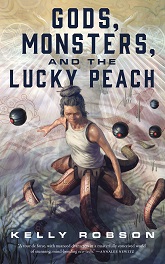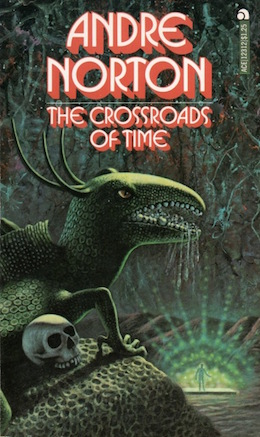Somehow in my head I seem to have conflated this novel and its sequel with any number of Doctor Who episodes. It’s not what I would call time travel, it’s parallel worlds—kind of a stripped-down version of The Man in the High Castle, with portals. Our Norton Hero(tm), named Blake Walker in this iteration, slips sidewise through time, rather than back and forth from past to future. He’s always in the same present, but with different outcomes based on the results of key decisions in the past of each world.
Norton had a thing for portal stories. The Crossroads of Time, published in 1956, is one of her earliest, and it’s another solid adventure with a relatable protagonist.
Blake has no family and a standard Norton backstory: policeman dad died in action, mom conveniently pined away and died; he’s on his way to art school in a carefully nameless metropolis (but from the evidence, it’s either New York or Chicago), until he gets caught up in a mysterious caper in the hallway of his hotel. There’s a gun, a hostage situation, a crew of apparent federal agents, and a situation that rapidly escalates, pulling Blake along with it.
In spite of his white-bread name, Blake is no ordinary Fifties American orphan on his way to college. He’s a brown-skinned foundling of unknown ethnicity—maybe Asian, but his hair isn’t black, it’s a very dark red—and he has the ability to sense danger before it hits. He’s quickly (maybe a bit much so) brought into the agents’ mission and filled in on what they’re doing.
They’re agents of the Service, an entity that polices travel through parallel worlds. They’re particularly concerned to track down and eliminate people who, in their own worlds, can’t do too much damage, but when they’re turned loose in other timelines, they can become tyrants and crime lords. To add to the challenge, both the agents and their quarry have psychic powers including telepathy, telekinesis, and mind control.
This group is pursuing a man named Pranj, who is collecting forces to dominate a number of “possibility worlds.” He’s been making inroads on Blake’s world (which may or may not be the same as ours), and he’s stolen a time carrier which allows him to travel to other worlds as well.
The agents persuade Blake to disappear for a while after he’s seen in their company, to keep him safe from Pranj. But Blake rapidly becomes bored; given the chance to get out of the safe house and run an errand, he falls into the middle of another good guy/bad guy fight, and ends up in a basement with one of the lesser bad guys, who calls himself Lefty.
The basement turns out to house Pranj’s carrier, and Lefty accidentally (or so it seems) activates it, sweeping Blake away with him to a world of empty apartments and deserted laboratories full of creepy-looking jars and bottles. Blake’s only desire is to get back home, but in the process of exploring this alternate reality, he discovers that Lefty is, in fact, Pranj. Blake makes a break for it, steals the carrier, and has to guess at how the controls work.
The guess is wrong. The carrier deposits him in an even bleaker world, full of massive ruins and haunted by weird mechanical worms controlled by hideous female creatures. A male human rescues him, who looks like a cross between a native Alaskan (Eskimo as Norton calls him, though that term is now considered pejorative) and a Pacific Islander. This “primitive” has plans to take Blake back to his tribe and show him off, but Blake makes a break for it, and after harrowing adventures (and the death of the Islander-lookalike), makes it back to the carrier and almost manages to get home.
But he’s just missed the mark. The city in which he finds himself is recognizably his own, but it’s a postapocalyptic hellscape, a battleground between “Nastys,” “hiders,” and the followers of a military mastermind called “the Sarge.” In this world, Hitler won the Battle of Britain, the United States was attacked and severely damaged but managed to hold off the Nazis with the help of the Free British, and civilization has collapsed. The U.S. has split into tiny, warring fiefdoms, and no one knows what’s happening in Europe.
The Sarge has been gathering together everyone who wants to fight to restore civilization. Since Blake’s carrier has been destroyed, he convinces the Sarge to help him find the agents’ own carrier—telling quite a few white lies in the process.
Pranj meanwhile has also landed in this world with an army of people from other worlds as well as this one. And then the agents show up, and capture Pranj with the help of Blake and another, much smaller recruit, a fluffy black kitten. Pranj has a cat phobia, and the kitten has been trained by one of the agents to assist in arresting Pranj.
When it’s all over, Blake can’t go back to his old life even if he wanted to. Because he has strong natural mental barriers, he can’t have his memories erased and new ones implanted; and the agents aren’t evil enough to want to eliminate him. It’s against the rules, but they enlist him as an agent.
The ending points toward further adventures, and maybe some answers to the question of who Blake is, where he comes from, and why he was left in that alley in Ohio in the timeline in which Hitler lost the Battle of Britain.
That’s next time, of course, with Quest Crosstime. Meanwhile, I have thoughts. This novel played in my head like a Fifties movie, with gangsters and Feds and retro-cool special effects. Pranj’s carrier is bare-bones, just a platform, whereas the agents’ is a nice, enclosed transport with buttons instead of basically a tiller. The alternate worlds play out like a classic sci-fi lab-and-skyscraper setting, bleak seaside ruins, and urban war zone complete with commando units, wolfpacks both canid and human, and plenty of guns and explosions.
Buy the Book


Gods, Monsters, and the Lucky Peach
What makes it notable, and characteristically Norton, is its quiet but persistent depiction of non-white characters and cultures. Some of that is of its time, as we say: calling characters Eskimo, Negro, “a Chinese.” Pranj’s haughty brown-skinned allies and the Islander character in the world of ruins lean a bit heavily on the “savage primitive” stereotype. It’s clear Norton’s own default is white—she describes Blake as having a “permanent sun tan.”
And yet, Blake is non-white and explicitly so, in a book published in 1956. Pranj the villain is a skinny blond. But most remarkable is the Sarge.
The Sarge is the great hope of his world, or at least his city. He served in the cavalry in World War II, when the US Army made the switch from horses to mechanized transport, and he knows both horse soldiering and modern weaponry. He also knows farm and animal husbandry, which is crucial his people’s ability to survive. He’s a strong leader and a gifted tactician, and he has coherent plans for restoring civilization.
He’s also black, from the Tenth Cavalry, the unit known as the Buffalo Soldiers. This is significant. The mid-Fifties were intensely aware of the inequities of race relations in the US. Crossroads of Time would have been written not too long after the verdict came down in Brown v. Board of Education, and I’m sure Norton was thinking of that when she portrayed Sarge in so positive and indeed heroic a light. It’s not a white man who will be saving this world, it’s a black man from an all-black military unit, commanding people of all races and ethnicities—and not all of them are men, either.
That’s interesting, too. So much of Norton’s work in this period is 100% male, and the agents of the Service certainly are—when they need a female, they dress up their slender blond agent in a skirt—but the Sarge’s soldiers include quite a few women. It’s as if Norton wants us to know that when the world is so broken that white men aren’t in charge any more, there’s finally room for non-whites and non-males to clean up the mess.
In the next installment, published a decade later, we get an actual female protagonist. That should be fun.
Judith Tarr’s first novel, The Isle of Glass, appeared in 1985. Her most recent novel, Dragons in the Earth, a contemporary fantasy set in Arizona, was published by Book View Cafe. In between, she’s written historicals and historical fantasies and epic fantasies and space operas, some of which have been published as ebooks from Book View Café. She has won the Crawford Award, and been a finalist for the World Fantasy Award and the Locus Award. She lives in Arizona with an assortment of cats, a blue-eyed dog, and a herd of Lipizzan horses.










